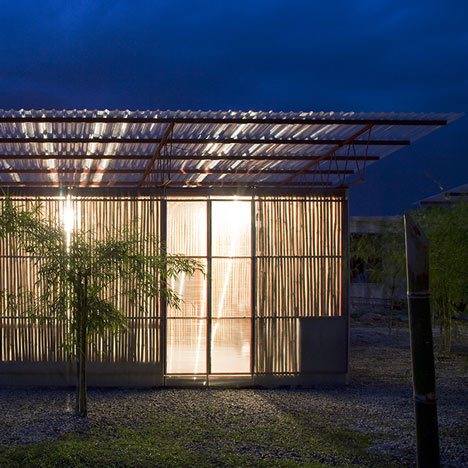The original post appeared on Dezeen. Article by Anna Winston
As part of our series focusing on the rising popularity of bamboo, here is a countdown of the ten most popular bamboo architecture projects on Dezeen, including a cafe, houses and a theatre as well as work by Kengo Kuma and Vo Trong Nghia (+ slideshow).
1. Bamboo Courtyard Teahouse by HWCD Associates
Most popular among Dezeen readers is this floating tea house in Yangzhou, by Chinese architects HWCD Associates, which is organised in asymmetric cubes that sit on a lake.
“The tea house is known as the bamboo courtyard as it mainly uses bamboo to create an interesting play of vertical and horizontal lines,” said the architect. “In some spaces, the vertical and horizontal elements intensify to form a psychedelic perspective, evoking a profound sensory perception.”
2. Kontum Indochine Cafe by Vo Trong Nghia Architects
Second most popular is this waterside cafe with striking bamboo columns by Vo Trong Nghia, who featured in our series of interviews with architects from the new bamboo movement this week.
The shape of the top-heavy columns in this restaurant designed for the Kontum Indochine Hotel in the designer’s home country of Vietnam are a reference to traditional fishing baskets used in the region and are echoed in the firm’s designs for the country’s Milan Expo Pavilion.
3. Low Cost House by Vo Trong Nghia Architects
Vo Trong Nghia is one of a number of architects also using bamboo to address some of the biggest challenges facing countries around the world – in this case housing for a rapidly growing population.
“The project started as voluntary work, responding to the serious housing issue for low income classes in Vietnam,” Vo Trong Nghia Architects told Dezeen. “We inspected Mekong Delta Area, where the housing problems for the poor are very serious.”
The result was this prototype for modular homes that use locally sourced materials to keep costs down and make them easy to assemble.
Thai designer Nattapon Klinsuwan of NKWD was inspired by the rock formations that create natural divisions in caves, where he noticed that “often the stalactite and stalagmite will connect and become a column, then a wall, creating rooms.”
To emulate this effect in the design for a hair salon interior, thousands of bamboo rods were hung from the ceiling in different lengths – in some places long enough to touch the floor – to create screens and permeable walls, separating the shampooing and colouring areas from the main space.
5. Wind and Water Bar by Vo Trong Nghia
Lengths of bamboo are bound together and bent into arches to create the supporting structure for this thatched dome, which sits in the middle of a lake in the Binh Duong Province in Vietnam and is used as a venue for music performances, local meetings and other events.
This project was one of the first we featured by Vo Trong Nghia, who recently told Dezeen that bamboo would be the “green steel of the 21st century”.
6. Blooming Bamboo Home by H&P Architects
The prototype house was designed by Vietnamese studio H&P Architects to sit on stilts in an attempt to create a structure that could withstand floods up to three metres above ground. Tightly packed rows of bamboo cane are used to form the floors, walls and roof, which can be propped open for additional ventilation.
“The house can keep people warm in the most severe conditions and help them control activities in the future, also contributing to ecological development as well as economic stabilisation,” said the architects.
See the rest of the article at Dezeen










